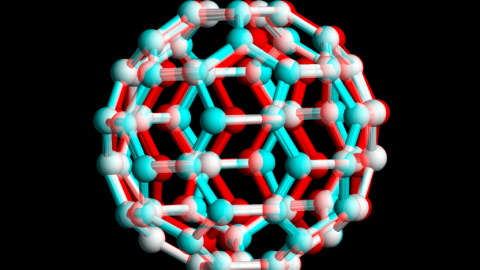The World of Nanotechnology

In my book Visions, I state that nanotechnology was first proposed by Nobel Laureate Richard Feynman in a seminal but witty article entitled “There’s Plenty of Room at the Bottom.” Feynman envisioned the theoretical capability of nanotech in 1959, stating: “I want to build a billion tiny factories, models of each other, which are manufacturing simultaneously…The principles of physics, as far as I can see, do not speak against the possibility of maneuvering things atom by atom. It is not an attempt to violate any laws; it is something, in principle, that can be done; but in practice, it has not been done because we are too big.”
There is a whole new world at the nanoscale that’s revealed by electron microscope, and even with scanning microscopes we can now move individual atoms. In fact, for a BBC Discovery documentary that I hosted, called “Visions of the Future,” I flew down to San Jose, where they had a scanning microscope and where I could move individual atoms–each about the size of a ping-pong ball–across a computer screen.
One main criticism of the full-scale development of nanotechnology has been that there is no equivalent of a wire by which to conduct electricity connecting the various parts of the nanomachine, giving it the power to operate and perform its necessary functions. This very problem, however, is currently being tackled by scientists with the implementation of carbon nanotubes (allotropes of carbon with a cylindrical nanostructure), which were discovered in 1991 by researchers at NEC. These tubes are among the stiffest and strongest fibers known to man and have outstanding electronic properties in addition to being able to function at extremes of temperature. Recent studies have shown, however, that a severe amount of damage can be caused to your lungs if carbon nanotubes are accidentally inhaled. Japanese researchers have shown that the tubes can eventually reach the outer tissue of your lungs, which just so happens to be the same location where asbestos causes cancer. These same researchers were able to induce mesothelioma in mice using the carbon nanotubes.
In my Science Channel series SCI-FI Science: Physics of the Impossible, I filmed an episode called “How to Become a Superhero” in which I explore the science behind carbon nanotube sheaths, testing the possibility of constructing a superhero suit with super-strength. (You can watch a short clip from the show via The Science Channel.) These sheaths are being used for the creation of carbon nanotube muscles which can expand and contract with a tremendous amount of speed. Normal muscles contract, for example, at a maximum rate of about 10% per second, while the carbon nanotube sheaths can contract at an astonishing 40,000% while still maintaining their strength and stability. These types of ground-breaking achievements, when perfected, hold considerable promise for revolutionizing all sorts of new developments, including robotic muscles, solar cells, organic light-emitting displays, or synthetic muscles for humans.
One of the goals of nanotechnology is to create nanomachines on the scale of living cells–such as proteins, DNA, or bacteria–and design them to perform equally complex tasks. These miniature mechanical devices could turn toxic waste into harmless matter, or they could travel through our blood vessels to mend cells from within. The first step toward building these nanomachines is to hack living systems at the molecular level and engineer them to do what we want.
These devices will be smart and autonomous, but just like the viruses and bacteria they are modeled on, they will have the potential to do enormous damage. For example, you may have heard of the scenario of gray goo and how nanobots or assemblers could run the risk of going haywire. In principle, gray goo is a large mass of self-replicating nanomachines that would eventually consume all matter in the galaxy by building copies of themselves, consuming everything in their path. This scenario has been brought into the mainstream by authors such as Michael Crichton, in whose book Prey, bacteria produce chemicals that are modified and then combined to form assemblers The final product gives rise to tiny flying robots. The main character lets a swarm of nanorobots loose into the atmosphere, where they prey on wildlife and replicate themselves along the way. These scenarios are farfetched and the complexities behind developing grey goo are presently beyond the capabilities of science, even though they aren’t ruled out by the laws of physics.
One application of nanotechnology that is currently in development is the use of nanoparticles to deliver various chemotherapy drugs specifically to cancer cells. Other medicinal benefits may include bone repair, nanochips for limb control (which could help revolutionize the treatment of paralysis), nanobots for gene therapy, or even microscopic nanodevices programmed to clear out your clogged arteries. In the future, swarms of invisible robots might permanently be patrolling our blood systems, repairing tissue and keeping us healthy.
The world of nanotechnology isn’t going away anytime soon, and it has already began to infiltrate literally every sector of industry. This trend, in turn, is creating a wide range of business opportunities, including drug delivery concepts, next-generation computer memory, bulletproof clothing, receptor enhancers, and even non-porous membranes that react to weather. The United States military is also paying close attention to the scientific advances of nanotechnology. It is currently working on the development and implementation of a 21st-century battle suit that would be able to stop bullets, detect biological and chemical agents, monitor a soldier’s vital signs, administer basic first aid, and communicate with headquarters. In fact, back in 2002 the Army granted $50 million to the Massachusetts Institute of Technology to create the Institute for Soldier Nanotechnologies. In 2007, more than $60 billion in products incorporating nanotechnology were sold. According to estimates, the amount may grow to over $2.5 trillion by 2014.
As we approach mid-decade we will be seeing the word “nanotechnology” a lot more as it’s limitless uses venture into the world of consumer products. You can already find nanotechnology being used in new dress shirts, household cleaners, sporting goods, toothpaste, cosmetics and even antibacterial water taps. The Project for Emerging Nanotechnologies for example, provides 800+ manufacturer-identified nanotechnology-based consumer products currently on the market in addition to a variety of other useful information.
You may even have products in your own home that have nanotechnology crontrolling things at the subatomic level and not even know it. You can use a variety of resources such as ScienceDaily’s Nanotechnology News or PhysOrg’s Nanotechnology News which inclues audio and video.
There is no doubt that the world of nanotechnology holds vast promises for innovation in virtually every industry known to mankind. The nano industry in itself is still quite new however, so only time will tell how much of a change it will actually have on the human condition. In the meantime, keep an eye on the headlines as you may find something that peaks your interest.
To be continued….





